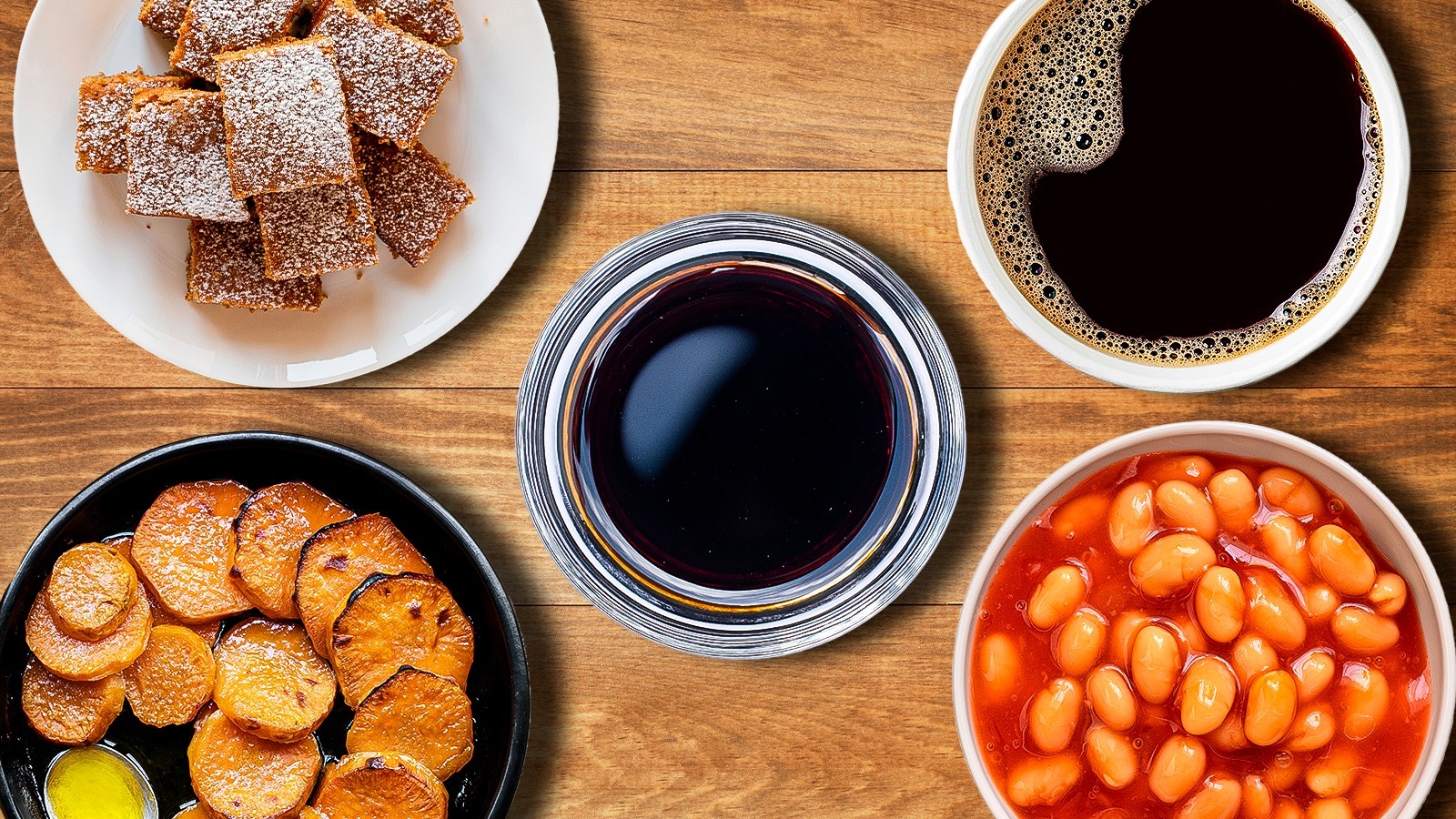Molasses makes a dynamic addition to both sweet and savory dishes because of its sweet, bitter, and earthy undertones. It’s been used since 500 B.C., and it’s a wonderful alternative to maple syrup, sugar, or agave when you want to bring different flavors to your dishes.
Before we get started with these creative ways to use this ingredient, you should know the different types of molasses. Each have unique colors and flavor profiles you might want to factor into your decision. The main distinction boils down (pun intended) to how long the molasses is simmered. Light molasses is, as the name suggests, the lightest in color — but it’s the sweetest, too. Dark molasses is just light molasses that gets boiled for longer, which results in a deeper color and thicker consistency. You’ll often see it used in gingerbread recipes and savory meals.
Blackstrap molasses is in a different ballpark, as it’s very dark and bittersweet. While you can use dark and light molasses interchangeably for most of these hacks based on your taste preference, there are some uses that warrant one over the other. No matter which type you choose, we recommend going for unsulphured molasses over sulphured — it has a milder, purer flavor because the sugarcane is ripened naturally in the sun rather than with the preservative sulfur dioxide added.
1. Molasses can amp up lentil sloppy Joe’s
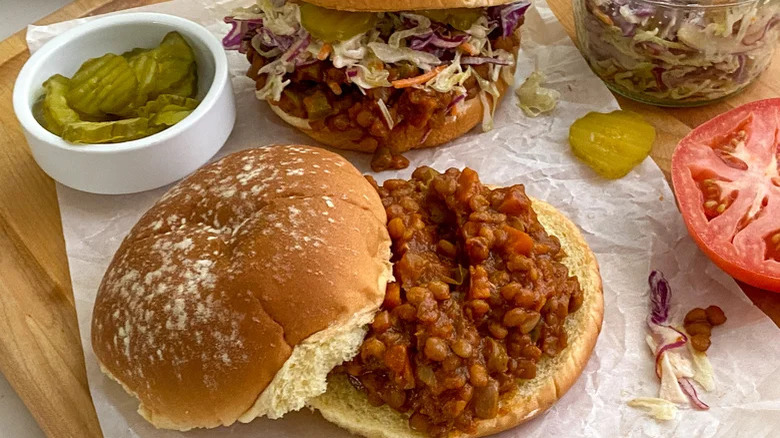
Sloppy Joe’s are a comforting, warm meal, but you may want to try a new method for making them. For example, try making a plant-based Instant Pot lentil sloppy Joes recipe — with a little help from molasses instead of a sweetener like brown sugar or agave. The lentils and the molasses make a hearty dinner that’s delicious and filled with protein and fiber. Plus, the medley of other ingredients, including tomato paste, liquid smoke, and soy sauce, makes every bite a delight. This concoction has the consistency of a thick stew, but when served on a bun, it replicates a sloppy Joe perfectly.
The molasses adds a subtle sweet note, which can be tweaked based on the flavors you’re looking for. It also contributes a hint of bitterness that contrasts the earthiness of the lentils. The flavor of molasses might get partially camouflaged amongst the other seasonings, but it brings more than a standard sugar would, with smoky and caramel notes to enrich your sloppy Joe. You can use light or dark molasses for this dish, but we recommend opting for dark molasses if you’re looking for a more bitter flavor. Enjoy this sloppy Joe sandwich with coleslaw or with a Caesar or Cobb salad.
2. Add complexity to BBQ sauce
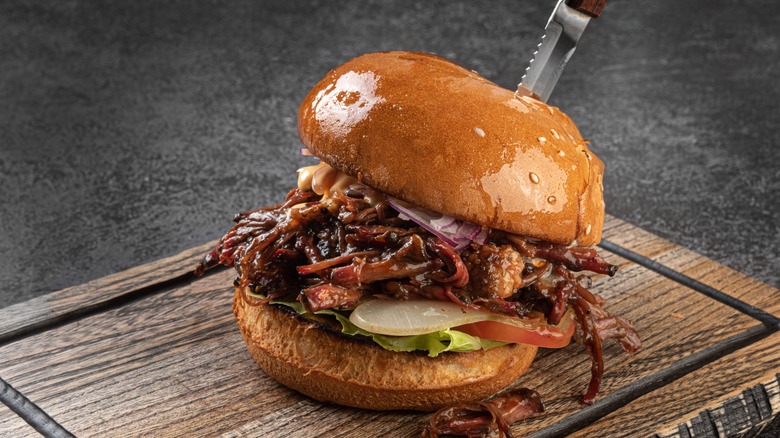
Seasonings can enhance the flavor of meat, give it texture, and make it more tender. So try working with molasses to give your meat seasonings a moist upgrade. It might not be the first thing you think of for meat, but it can make both homemade and store-bought bottled barbecue sauce sweeter and stickier. While you will often find honey or maple syrup as a common choice for the sauce, molasses isn’t as cloying, and its caramelized, smoky taste brings more complexity than mere sweetness.
Use dark molasses for a deep, bold, less sugary option compared to the lighter version. However, either will do the trick. If the sauce still seems too liquidy, especially if you make sweet and tangy BBQ sauce from scratch with ingredients like wine vinegar, ketchup, and Worcestershire sauce, try simmering it on the stove for a few minutes until it thickens. To avoid concerns over the sugary coating burning, we recommend using it near the end or once the meat is cooked. Spread some onto a burger, mix it with a pulled pork sandwich, or use it as a dip for vegetables.
3. Use molasses to heighten a cocktail

Sweet additions, such as simple syrup, are no strangers to cocktails. Using molasses provides a deep and welcome flavor to elevate a drink. Make a gingerbread old fashioned with either light or dark molasses, but you should pick the dark version when you want a more noticeable color. Like many cocktails, this involves a syrup, which you can also use to make a hot toddy or a gingerbread Manhattan. Here, we’d use a beautifully flavored gingerbread syrup made with molasses and spices. This is a cold drink, but it’s also surprisingly comforting.
If you desire something more fruit-forward, an apple cider old fashioned may do the trick. This also has black walnut and toasted almond bitters for a combination of nutty, bitter, sweet, and spiced flavors. This libation doesn’t require simple syrup, and instead, we’d recommend swapping the recipe’s muddled sugar cube for molasses to make a complex caramel-y addition that tastes superb with the apple. Mix the molasses, bitters, and bourbon whiskey until dissolved, then top with apple cider.
4. Sweeten up oatmeal with this sugary alternative
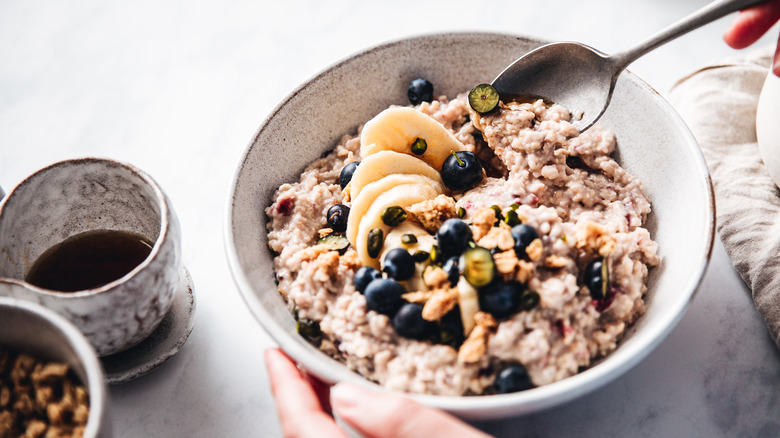
Alvarez/Getty Images
Sprinkling brown sugar onto oatmeal is a tale as old as time — but molasses makes a perfect alternative when you want a more detectable flavor. You can use any of the molasses types. Light molasses is the most seamless alternative to brown sugar with a caramel-like flavor. It tastes great with chopped fruits and nut butters. Choose dark molasses if you want to pair it with cloves and allspice for a spiced, sweet, and undeniably scrumptious morning oatmeal. Top this with raisins or sliced apples.
If you want something that provides intensity, a bitter flavor, and a hint of sweetness, pick blackstrap molasses. Add it with banana and nuts for an earthiness that works perfectly with the oats. For a savory oatmeal, you’ll want to complement the bitterness with other savory components, like wilted spinach, so you get other notes with each bite. Rather than swirling molasses on top at the end like you might with honey, mix it fully into the oatmeal. This means cooking it directly with the oats or stirring it in the bowl once plated until it’s incorporated. Blackstrap is the most concentrated form of molasses, so use a small amount, mix, taste, and see if you want to add more.
5. Include molasses in buttercream frosting
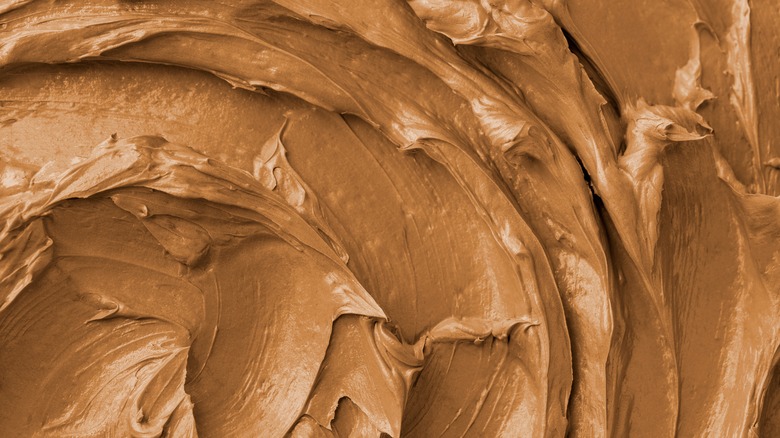
When you want something more decadent than classic, don’t be afraid to swap sugar with molasses in buttercream frosting. The great thing about molasses is that it’s potent and thick, and you don’t need to add a lot — just a tablespoon added to a few cups of powdered sugar will do. But while molasses is thick, it still has a wet, liquid component. You will want to slowly add the molasses into the sugar, stirring gently, until you get your desired consistency.
For a straightforward sweetness, light or dark molasses are the best choices. Dark molasses adds a special smoky flavor to the buttercream frosting but doesn’t overtake it. The biggest difference is the frosting’s color, which will have a brown hue. If this is a concern, light molasses is the most pleasing choice. This syrup creates a distinct taste that you can add on top of cakes and cupcakes to give them a caramel-adjacent flavor. Add a bit of pumpkin pie spice to use on gingerbread baked goods.
6. Put a spin on soup with a hint of this ingredient
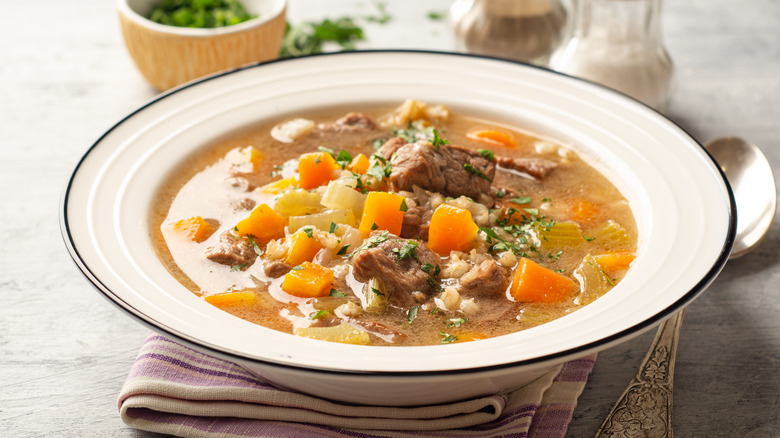
You might scoff at the thought of adding molasses to soup, but it’s not too strange at all. Molasses doesn’t turn it into a sugar soup, but instead creates a nuanced flavor that you can use in something like a beef, ham, lamb, or bean-based soup. It gives a noticeable richness that tastes balanced with the acidity of lemon juice or tomatoes. Include your veggies of choice, such as carrots, celery, onions, or pumpkin (though technically a fruit), for both color and nutrients.
The molasses does add a sweet component, but you’re not necessarily adding it in excess like you would for a baked good. In this case, we’re working with the deep, not-as-sweet bitterness from dark molasses. This unexpected ingredient enhances the earthy notes from vegetables while also adding a slightly smoky component. Molasses is helpful to move the taste forward if you have minimal ingredients to work with. It elevates soups in the same way that sugar is sometimes included in a tomato soup to balance the sharpness.
7. Transform a cup of coffee with molasses

It’s no secret that people add sugar and syrups to regular cups of coffee, as well as coffee drinks like lattes. You’ll often find some fun coffee combinations, such as an iced latte with lavender syrup or a sweet, citrusy, chocolatey orange mocha coffee. But you might want to give your mug of coffee a bolder flavor with molasses. This can be mixed in for a sweetened black coffee, but you could also jazz it up with other additions like oat milk for a creamier version. Or include cinnamon or vanilla for added aroma and richness.
Like baked goods or cocktails, molasses goes incognito as it disguises itself in the darkness of the coffee. This welcome choice complements the coffee’s bitterness and transforms your morning drink into a fierce, complex gem. The molasses should dissolve quickly in the heat of the coffee, but if you opt for an iced Joe, give it a good stir until it’s incorporated. This is an intriguing way to enhance a cuppa when you seek something other than sugar or maple syrup. If you need a bit of inspiration, test it in a comforting gingerbread latte.
8. Try this sweet syrupy addition in a pie
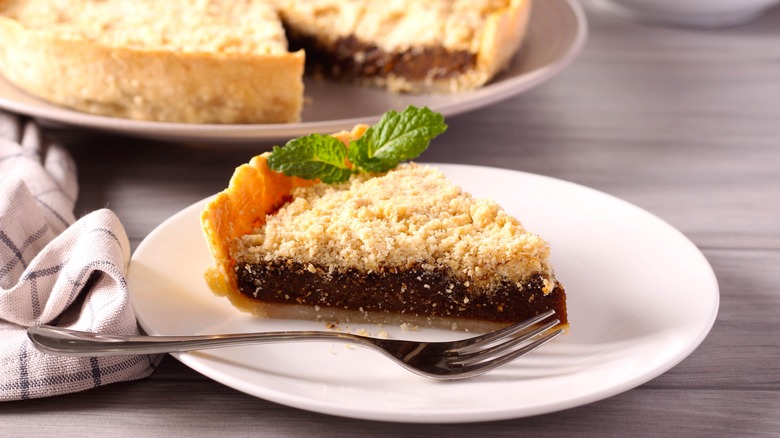
Molasses has been used in pies for centuries. Take the classic pumpkin pie: Notably, an unexpected molasses shortage led the town of Colchester, Connecticut to postpone its 1705 Thanksgiving when it meant no pumpkin pie to feast on. Molasses provides a caramel-like flavor and color to intensify the pie’s earthiness.
If you don’t have a craving for pumpkin pie, you might want to try a shoofly pie instead. It similarly features unsulphured molasses (which is perfect for baking since, as previously mentioned, it’s sweeter and milder than the sulphured), but boasts a unique method of creation. The thick syrup gets mixed with hot water, poured into the pie crust, and baked. The molasses-water mixture reduces to turn into a unique gooey pie with a crumbly topping. This is a sweet and spiced pie that you can serve with ice cream or top with fruit for a pretty quick dessert. This recipe takes only an hour to prepare and uses a frozen pie crust for convenience.
Molasses can ultimately be a sugar substitute in your pie of choice when you want a different but rich filling that pairs well with spices, like ginger, cinnamon, and nutmeg. It can also feature in a fruit-based pie, such as apple.
9. Provide a sweet upgrade to veggie-based dishes
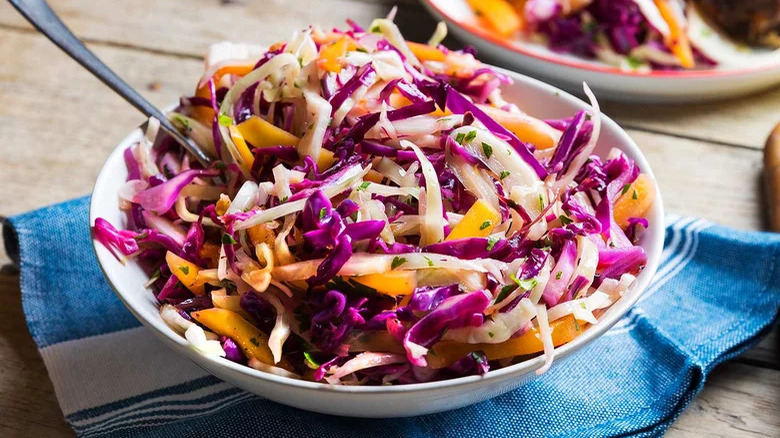
You’ll never look back after you try light or dark molasses with vegetables. Unless you want a very sweet veggie, you don’t have to use much syrup. Start off strong with a grilled cabbage and mango slaw that’s vibrant and blends both sweet and spice with its juicy mango, molasses, jalapeño vinaigrette. First, grill the cabbage and mango. Once they have a char, then mix them with the olive oil, molasses, and other ingredients that act as a dressing. This is an eye-catching appetizer with an unanticipated combination of veggies and seasonings.
The molasses works with the mango to provide sweetness, but there isn’t a lot of it in relation to the substantial amount of cabbage. It just provides a peaceful balance to the zingy jalapeño. If you want something where the molasses is more front and center, make candied yams that will impress your family. Molasses, when roasted, has a caramelized texture that transforms a drab veggie into an incredible one. The yams are sweet and soft, with a burst of citrus from orange zest. This is more aligned with an autumn or winter meal.
10. Molasses gives complexity to loaf breads

Loaf breads are a treat, and numerous recipes incorporate dark or light molasses. Just keep in mind the color change that molasses contributes. If you want a white loaf, molasses is not your friend. Instead, implement this ingredient when baking applesauce bread, which has a few other sweet components, including sugar, applesauce, and raisins. This blend is sweet but spiced, with the color coming not only from the molasses but the applesauce, wheat germ, and seasonings, too. The batter is also quite wet, which contributes to its overall moistness after the baking process.
Keeping on the spice train, try your hand at a spiced sweet potato bread. Grated sweet potato is the star, but you could also add nuts, such as walnuts or pecans, if you want to break up the texture. Since there are so many other ingredients to help it all come together, molasses plays a more subtle role. Both of these loaves are perfect in the morning, heated up with a pad of butter and a hot cup of tea, but it can easily serve as a snack at any time.
For a less dessert-based loaf, opt for a sweet brown bread, which calls for molasses and honey. The above quick bread recipes simply combine ingredients; but this dough contains yeast, which needs to be activated with warm water before mixing everything together, kneading, proofing, and baking.
11. Put some in your next smoothie or smoothie bowl
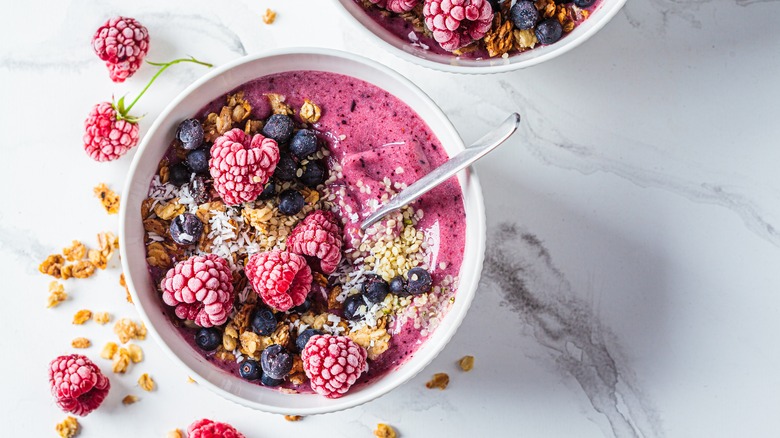
Give your next smoothie or smoothie bowl a pronounced flavor boost with molasses — you can integrate this ingredient into either, depending on whether you’re in the mood to enjoy it through a straw or with a spoon. However, smoothie bowls also have an added aesthetic component, as you’re able to decorate them with toppings, such as granola, chia seeds, shredded coconut, or more fruit. Light and dark molasses are the easiest to work with when it comes to fruit smoothies. The bite from dark molasses complements the tartness you’d find in blueberries, blackberries, or raspberries. This is a great choice if you don’t want an overly saccharine start to the day. Smoothies with sweeter fruits, like mango or peaches, should use light molasses. Use frozen fruit if you want a thicker smoothie.
Consider using blackstrap molasses when you prefer a gingerbread type of smoothie with a spiced base, not fruit, or if you’re also using honey. The honey and molasses create a strong brown sugar flavor. No matter which molasses you choose, blend it directly with the rest of the components so it’s fully integrated into your concoction.
12. Balance acidity in tomato-based pasta sauce with molasses
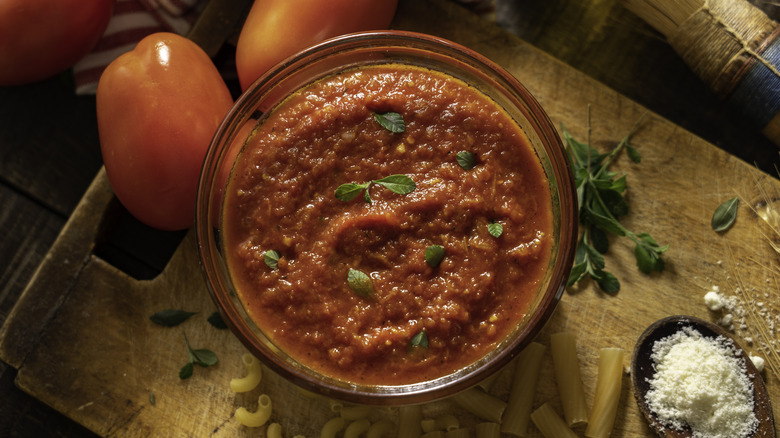
If you’re warming up tomato sauce for dinner and find it tastes too acidic, you can offset the tang by adding molasses. There isn’t a set amount to add since it depends on how big a batch of sauce you’re making and the tomatoes’ unique acidic content. Either way, you’re not turning it into a sugary tomato sauce with a heap of the brown syrup — it’s there to even the flavor out. Use merely a small amount of light molasses because of its high sugar content and mild taste. If you opt for the dark alternative, it offers a bitter balance that makes it an ideal choice for savory recipes. Just be careful that it doesn’t make the sauce too harsh.
Whichever option you pick, note that the molasses provides a more daring body of flavor than if you were to use sugar. But don’t be concerned if it alters the color of your tomato sauce. Add in your favorite fresh or dried herbs, whether that’s parsley, oregano, or sage, which complement the pungency of the molasses. Fresh oregano can be bitter, too, so choose the dried version or work with a different herb if this is a concern. Whether homemade or store-purchased, this ingredient is the subtly sweet upgrade your pasta sauce needs.
13. Bake cookies (other than standard gingersnaps)
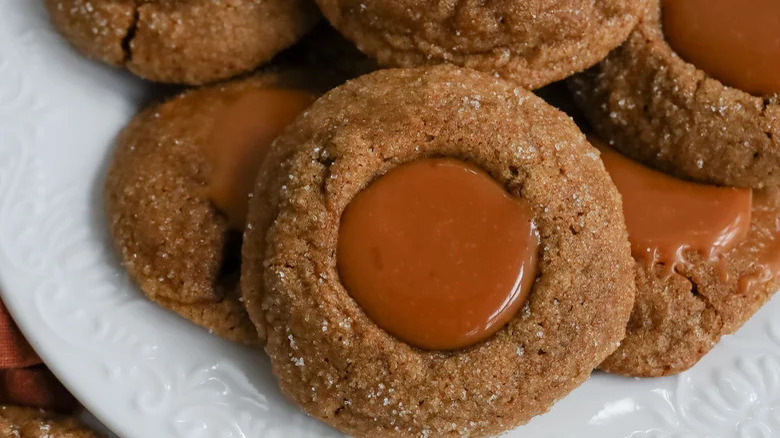
Gingersnaps are a heavenly cookie to enjoy, but we have plenty of other ideas that integrate molasses when you seek something other than the standard snap. Try baking salted caramel ginger thumbprint cookies, which mix buttery caramel, creamy white chocolate, and molasses for a drool-worthy treat. You’ll often see thumbprint cookies with jam, but this kicks the sweetness in a different direction. Light molasses is the most satisfactory for a substantial sweetness, but mellower dark molasses can pair well with the spices. Either type mixes with brown sugar for a caramel taste that gets doubled and upgraded with the caramel topping.
If you’re not a fan of oatmeal raisin cookies, choose the raisin-free soft iced oatmeal cookies. The brown-sugar-to-molasses ratio can be customized to anything from 1 teaspoon of molasses with 1 cup of brown sugar, to a half a cup of molasses to a cup of sugar. This is a significant range that will offer a dynamic taste. If you choose the smaller amount of molasses, it remains concealed in flavor but still offers a soft, chewy component.
14. Complement baked beans’ sweetness with molasses
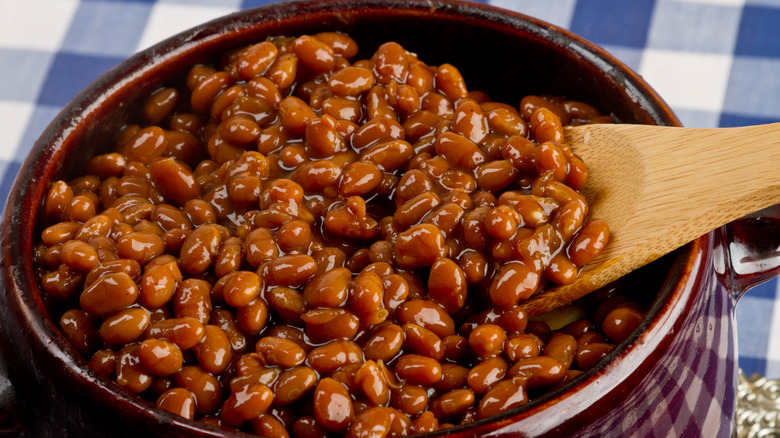
Molasses can make all the difference in baked beans, giving them a well-rounded taste. But it also aids in the thickening process for a consistency similar to chili, which is heavy on the beans with a nominal amount of liquid. Baked beans perfectly blend sweet and savory in a similar fashion that you’d find with red bean paste. Make sugary and delicious slow cooker baked beans as a dinner side dish. This recipe uses a myriad of legumes — black, kidney, and navy beans — in addition to bacon, barbecue sauce, gochujang, and a splash of apple cider vinegar.
These come together to make a memorable dish unlike any other baked beans you’ve had before. The gochujang, while spicy, also has a sweet component to pull this even more into the candied bean category. If you’re not sold on molasses with beans, take Giada De Laurentiis’ word for it. The brown syrup complements each ingredient in her recipe — which also calls for cannellini beans, balsamic vinegar, dark beer, tomato paste, and pancetta — and subtly ties the whole dish together.
Static Media owns and operates Look, Mashed, and The Daily Meal.



